Conditions for the smooth operation of the toilet cistern valve: troubleshooting
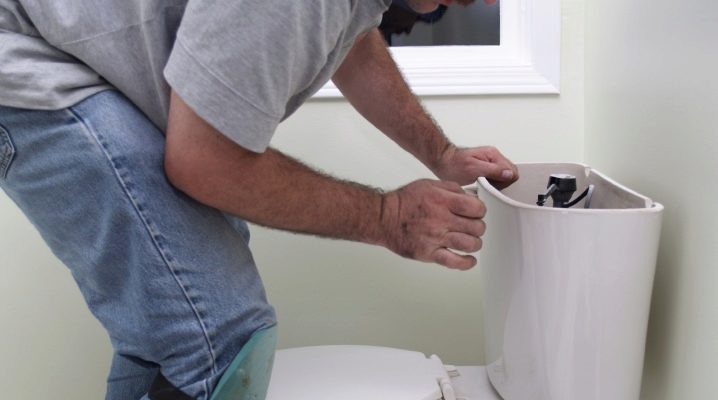
Plumbing in the house is difficult to repair. And the bathroom with all the accessories is no exception. But there will be no problems if you know the device and the causes of problems with the toilet. Knowing is almost half the battle on the road to skill.
Toilet bowl design
Structurally, a standard toilet bowl consists of two main parts: a flush (flush) cistern and a bowl. These parts are containers, the first of which serves to accumulate water, store it and drain it into the bowl, and the second is connected to a sewer riser, where the contents are flushed out of the bowl.
The following elements are present in modern types of bowls:
- the bowl itself with fixing drips;
- release device;
- plastic seat with cover included.
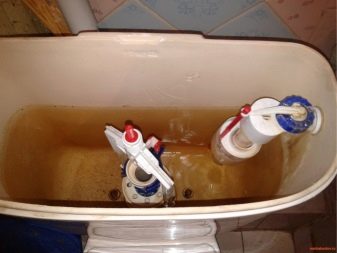

Bowls for installation in apartments are made of porcelain or faience. In non-residential buildings, plastic and metal products are installed. In old houses, there are still cast-iron toilets, but they are unlikely to be found on sale.
The outlet from the bowl is arranged with an upward bend of the outlet so that there is always water at the beginning of the bend. A water seal is formed, which prevents unpleasant odors from the sewer riser of the house from entering the toilet room.
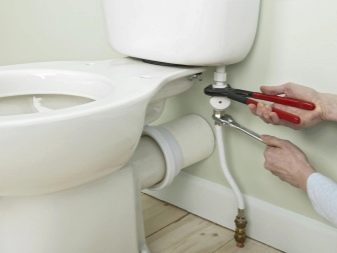

There are two groups of toilet bowls according to the design of the outlet pipe:
- with a horizontal outlet, when the direction of the branch pipe is parallel or at a slight angle downward to the floor surface;
- with a vertical outlet, in which the branch pipe is directed vertically downward.
The second variant of distribution in Russia did not receive due to standard projects of sewage devices in apartment buildings, which do not make it possible to install toilet bowls of this group. It is suitable for private homeowners building their own homes.
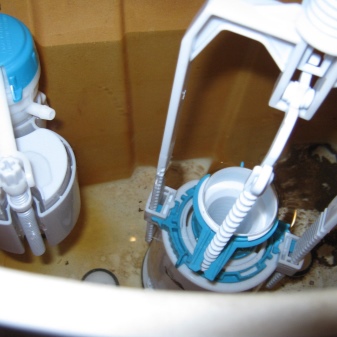

The waste tank is a reservoir for flushing water and is always located above the bowl. The higher the tank is installed, the more powerful the flushing water flow and the cleaner the bowl.
The tank in modern plumbing is attached:
- directly on the mounting shelf on the back of the toilet bowl ("compact", the most popular option);
- to the wall at a certain height from the bowl installation (suspended structure);
- discreetly into the wall (built-in tank).
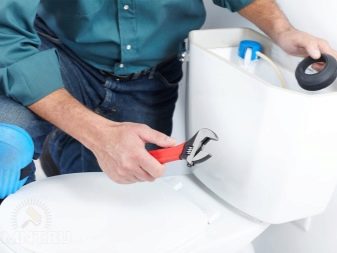
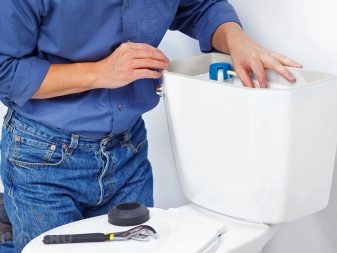
There are only two devices inside the tank: a water storage system and a water drainage system. These devices have shut-off and drain fittings, including a shut-off valve and a valve for filling and adjusting the water level. This also includes a float and a water drain lever.
Inlet fittings device
There are two types of water inlet tanks:
- side water inlet, when the inlet of the tank is located on the side of it in the upper part;
- bottom inlet, assuming the location of the water inlet at the bottom of the tank.
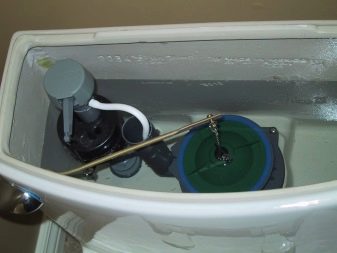
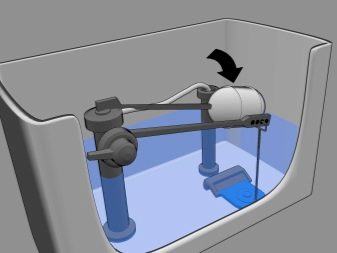
In flush tanks with a side water supply at the inlet, a fluid inlet valve is located. The valve is connected to a device for closing it, consisting of a horizontally located float on a curved brass lever (rocker). In tanks with a lower water supply, the inlet valve is also located at the inlet at the bottom, but the float is not horizontal in the tank, but vertical. In any intake design, the main component of the intake valve is the diaphragm. Occasionally a piston valve is used instead of a diaphragm valve.
There is nothing complicated in the mechanism for draining water, although there are many modifications associated with saving water. The mechanism drains the existing supply of water into the toilet.Part of the drain is the overflow from the tank, which prevents the tank from overflowing in the event of a malfunction of the water inlet valve. The drain system includes a bleed valve, a bleed lever (or button), an outlet valve seat, a stem, and a stem guide.
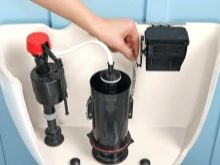
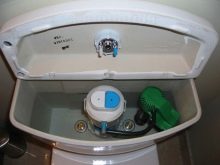
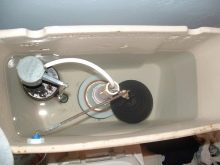
Mechanism operation
The principle of operation of the entire flushing device does not differ in any way from the model used for a long time. The drain from the cistern in modern versions of the toilet is absolutely identical to the drain in the corresponding devices of the Soviet era. The collection of liquid in the tank comes from the water supply of the apartment. To turn off the water supply to the toilet, there must be a shut-off valve. Faults with the toilet are as common as with the plumbing, and most importantly, they do not coincide in time. In order to fix problems with the toilet, it is necessary to block the line from the water supply.
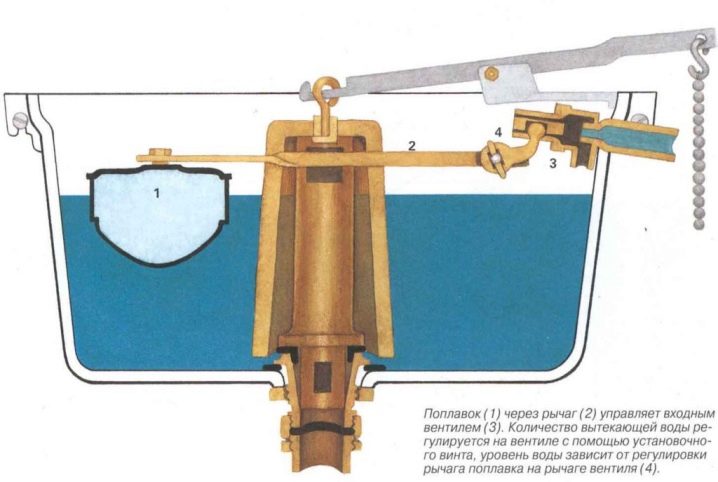
If the water is drained from the tank, then the float is in the lower position of the tankopening the water inlet path through the inlet valve. As the level of liquid in the tank rises, the float floats up, gradually closing the inlet valve. Reaching a certain level of liquid in the tank, the floating float through the rocker arm connected to the valve membrane completely blocks the flow of water into the tank. At the same time, by the force of the pressure of the liquid level, the diaphragm valve of the release, which is located on the stem of the drain, is pressed against its seat. If the fittings are in good working order, the drainage system does not let the liquid out of the tank.
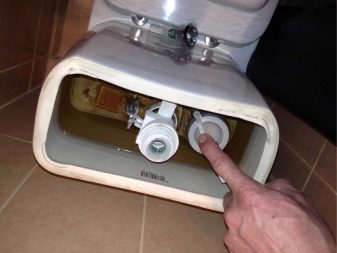
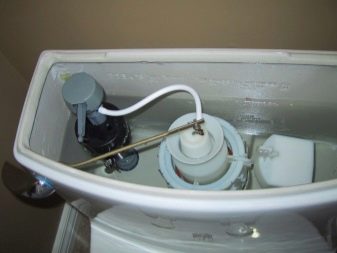
To activate the flush, you need to pull the lever or press the release button on the tank. The bleed valve opens. Water rushes into the toilet bowl. The dual-mode cistern has two release buttons: a small volume of the working medium for flushing and a full flush. After emptying the tank, the inlet float is in the lower position and opens the inlet valve. The cycle of the system is repeated.

Assembly
To assemble and use a toilet bowl with all devices, you need to follow the algorithm (using the example of the popular “compact” type with horizontal outlet):
- turn off the water on the old toilet;
- dismantle the old toilet and cistern;
- install the bowl and mark the attachment points if they do not coincide with the old ones;
- drill holes and insert dowels into them;
- put the bowl in place, insert the fasteners and slightly fasten them;
- check the horizontality of the installed bowl according to the level;
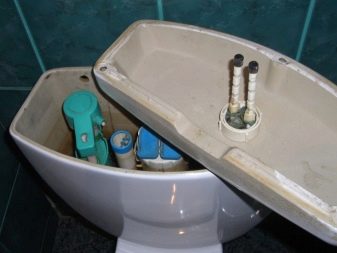

- install the toilet lid and seat;
- perform the work of connecting the outlet of the bowl to the sewer pipe by means of a sealing collar, while treating the ends of the connections with sealant;
- seal the junction of the bowl with the floor and finally tighten its fasteners;
- install the tank (usually all the elements of the tank are ready-made);
- lubricate the ring of the cistern opening to the toilet mounting shelf with sealant and install the container in the place of attachment;

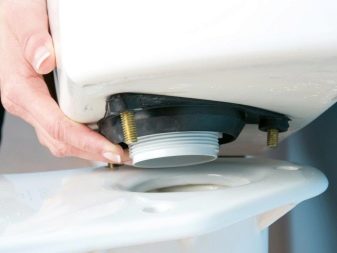
- tighten the bolts for connecting the tank to the toilet and install the lid on the tank;
- connect a flexible hose from the water supply to the tank;
- check the operation of toilet devices;
- in case of malfunctions, all systems need to be adjusted and the malfunctions eliminated.
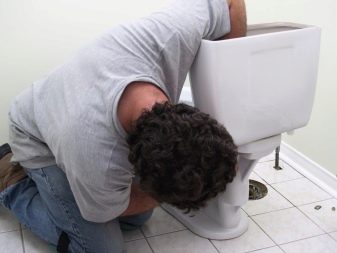
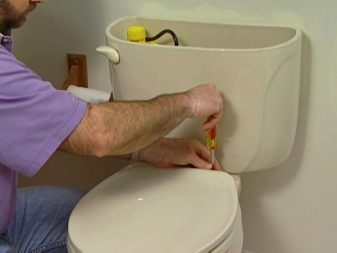
If everything is in order, then you can start using the device.
Causes and troubleshooting
The most common problems are leaks through the tank drain system.
The remedy depends on the cause.
- The adjustment of the float of the water inlet system to the tank is violated and therefore excess water flows through the overflow. It is necessary to open the tank and by bending the float lever to achieve the desired adjustment of the water level in the tank. Bending the float changes the water level.
- The tightness of the seat or the bulb on the drain of the tank is broken, so they do not keep the required fluid level. Plaque can build up on the pear and saddle, and they can also become deformed. The bulb and seat gasket should be cleaned or replaced.

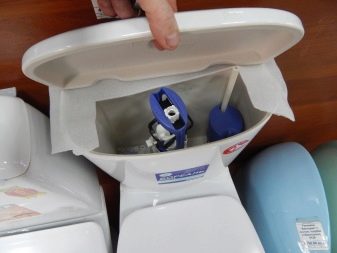
- Water is not collected in the tank. If the inlet valve is clean, then the possible cause is in the supply pipe, hose or faucet.You can disconnect the hose and check the water pressure in the system. When confirming the cause of the supply connections, the hose, water filter or tap must be cleaned or replaced.
- Intake valve leaks after leveling up. Sometimes it's all about incorrect level adjustment, as a result of which the float rests against the tank lid. You can adjust the level (decrease it) by bending the brass float arm.
- It flows at the water inlet to the tank. Adjust the level below the inlet and replace the rubber gaskets on that opening.
- The water drain button (lever) does not work due to mechanical reasons or the displacement of the flush mechanism parts. Parts can be replaced and adjusted as required.
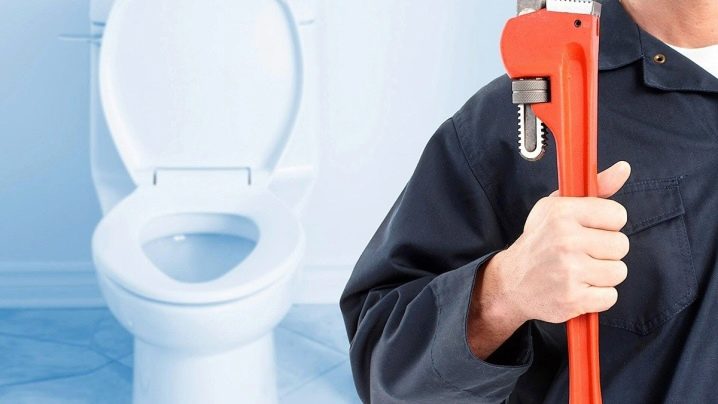
Many faults can be eliminated on your own, without the involvement of plumbers.
Useful Tips
In order for all toilet systems to work smoothly, you need:
- periodically inspect fittings, gaskets, supply hose;
- timely identify and eliminate system leaks;
- control and regulate the correct level of liquid in the tank;
- periodically clean the parts of the water supply and drainage system from contamination.
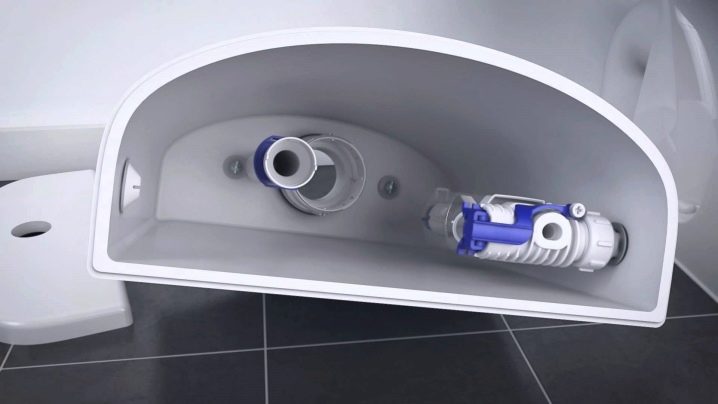
Plumbing in the house is needed to provide some comfort in life. And her good work depends only on the people themselves and on their knowledge of how to handle it.
For information on how to troubleshoot the smooth operation of the toilet cistern valve, see the following video.













The comment was sent successfully.